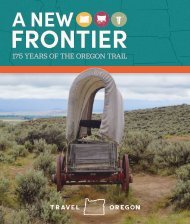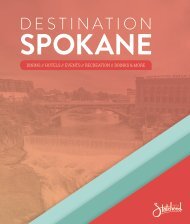Create successful ePaper yourself
Turn your PDF publications into a flip-book with our unique Google optimized e-Paper software.
Road Reconsidered<br />
Around the State<br />
left: Bannock Indians photographed in the 1870’s by<br />
William H. Jackson on the Fort Hall Indian Reservation.<br />
On horseback at the extreme left is Buffalo Horn. Buffalo<br />
Jim is next to him. BElow: Dead sheep that were<br />
shot in the Sheepshooter War. The largest sheep massacre<br />
was near Benjamin Lake in 1903 when 2,400 animals<br />
were killed.<br />
Photo credit Smithsonian<br />
The Bannock-Paiute Indian War of 1878 in Oregon<br />
The Bannock War, also called Egan’s War, started in 1878 after settlers on Camas Prairie<br />
in Idaho allowed their hogs to root up and destroy camas fields that were the basis for the<br />
Bannock Tribe’s sustenance. It was the last in a growing body of transgressions against the<br />
Bannock Tribes. After leading a revolt against the whites on Camas Prairie, Buffalo Horn<br />
led the Bannocks from the Fort Hall Reservation to eastern Oregon to join with the Paiute<br />
tribes. A battle between soldiers and Indians, now led by Paiute Chief Egan, occurred at<br />
Silver Creek, not far from the present town of Riley, 24 miles west of Burns. Colonel Reuben<br />
F. Bernard found the Indians encamped at Silver Creek on a rocky flat near the abandoned<br />
site of the U.S. Army Camp Curry. The Paiutes and Bannocks numbered nearly 2,000. Of<br />
this group, 700 were warriors. The soldiers were outnumbered, but Bernard led a surprise<br />
attack on the morning of June 23, 1878. One soldier and an estimated ten to fifty Indians<br />
were killed, before the Indians fled to the north through Grant County.<br />
The Sheep Wars<br />
Between the years of 1896 and 1906, Central<br />
Oregon was the site of armed conflict<br />
between sheepherders and cattlemen that<br />
eventually led to the killing of more than<br />
10,000 sheep and a number of people.<br />
These range wars included the burning of<br />
numerous ranches, sheep sheds, haystacks,<br />
and the killing of cattle. It began with the<br />
formation of several associations, whose<br />
leaders and members remain unknown to<br />
this day. This led to the largest slaughter of<br />
sheep that took place in the American West.<br />
Rabbit Drives<br />
The Paiute Indians were a resourceful<br />
people. They utilized everything in their<br />
environment that could possibly benefit<br />
them. One strategy for getting meat and<br />
fur pelts involved driving rabbits into a<br />
rope fence and clubbing them. The early<br />
homesteaders copied Paiute methods to<br />
reduce the hordes of rabbits that would eat<br />
gardens and crops.<br />
1859 oregon's magazine winter <strong>2010</strong> 21

















